Stress can affect your dog’s health, happiness and behaviour – but the signs are often missed. Here are 23 common canine stress signals, along with tips for helping your dog to relax.

As humans, we often underestimate how seemingly “normal” events can trigger stress and anxiety in our canine friends.
It’s hard to imagine that a guest visiting or short car journey, for example, can be difficult for a dog to cope with.
Stress can’t be ignored though. While short-term (acute) stress can make your dog unhappy and fearful, long-term (chronic) stress can cause serious health problems. Many owners also overlook the effect stress can have on their dog’s behaviour.
Unfortunately, the subtle signs of stress in dogs are often missed, ignored, or misunderstood. This can mean the dog is repeatedly exposed to the same triggers, despite many signals that he’s uncomfortable or scared.
So, to help you identify and relieve stress in your dog, we’ve put together a complete guide to canine stress. By the end of this guide, you’ll understand the basic physiology of stress, what causes it, how to notice when your dog is stressed, and how to relieve it.
What Exactly is Stress?
Some people find it hard to believe that dogs can feel chronically stressed. After all, they don’t have jobs, money problems or a family to care for – what are they stressed about?
This type of thinking shows a mis-understanding of what we mean by stress.
Stress is a physiological process that evolved as a response to potential danger. When the brain identifies a threat, it starts a cascade of internal processes to prepare the dog to either fight or run away.
To achieve this, a range of hormones are released. These include:
- Adrenaline – This is the first hormone secreted when a dog is stressed. It prepares the body for “fight or flight” by increasing heart rate and blood sugar levels. Adrenaline also increases respiratory rate, as a higher heart rate means the dog needs to pant to maintain blood oxygen levels.
- Cortisol – After adrenaline, a stressed dog’s body secretes cortisol. This is a stress hormone that increases the amount of fatty acids and glucose in the blood, so that the dog’s muscles and organs are prepared for activity.
- Testosterone – The sex hormone testosterone is released by both males and females during a stress reaction. It can increase the chances of an aggressive response. While less testosterone is released in neutered dogs, a small amount is still produced by the adrenal glands.
There are many secondary effects of increasing the level of these hormones. These include increased blood pressure, heart rate, body temperature, respiratory rate and fuel concentration in the blood. Stress also slows down the digestive system and causes the body to stop repairing muscles.
These effects are useful when responding to a stressful event – as long as the body returns to a non-stressed state quickly once the “threat” has passed.
Unfortunately, many dogs are living in a state of chronic stress. Long-term stress disrupts the body’s natural feedback mechanisms, leading to continuously elevated cortisol levels. This can have a severe effect on the dog’s health, behaviour and happiness.
Key Point: Stress is a subconscious reaction to a trigger (or “stressor”) that changes hormone levels in the body. This can lead to reactions such as barking, aggression and other stress signals. These are not symptoms of a dog misbehaving or being “bad.” Instead, they are side effects of stress – something which your dog has no conscious control.

Why Do Dogs Get Stressed?
Stress triggers vary depending on genetics, temperament and past experiences. Even if a dog hasn’t had a previous negative experience with a trigger, a lack of exposure to the stimulus before 16 weeks (the critical socialisation window) increases the chance of reactivity towards it.
- Noise. Loud noises, such as thunderstorms or fireworks, can cause prolonged stress. Some dogs also find more mundane noises to be stressful. If your dog looks up every time a car goes past the house, for example, he might be anticipating someone coming to the door. Noises are also often involved in “trigger stacking” (see box later in article) – where successive noises increase cortisol levels, until the dog is reacting to noises he would usually ignore.
- New Experiences or Objects. Dogs find novelty stressful. Everything from a new item in the home to meeting new people could trigger a stress response. You should allow a dog to become comfortable with a new person or item in their own time, rather than forcing an interaction.
- Owner’s Mood. There’s evidence to suggest that a dog’s stress levels can match those of their owners. All dogs can detect elevated hormone levels in humans, including cortisol (a stress hormone). When an owner’s cortisol is high, the dog may become stressed and anxious, as they need to be hypervigilant to signs of danger. The consequences of chronic stress in the owner can also cause the dog to become stressed, such as more household arguments, loss of routine, and emotional outbursts.
- Other Dogs. Meeting other dogs can be stressful – especially as many dogs simply don’t enjoy interacting with canines. While all meetings have the potential to trigger the release of stress hormones, those in enclosed environments, or on a leash, can be particularly difficult for a dog. If the dog doesn’t feel they can escape from a situation (“flight”) then they may feel they need to defend themselves (“fight”).
- Lack of Exercise. Dogs need regular exercise to stay happy and healthy. Despite being a form of physical stress in itself, exercise reduces both cortisol and adrenaline levels, while releasing endorphins. Make sure the exercise is safe and enjoyable for your pet though. We recommend avoiding ball throwing, as this can put a lot of strain on the joints and also becomes obsessive for many dogs. Running or cycling with a dog can also be stressful, as the dog can’t set their own pace or explore the environment.
- Lack of Mental Stimulation. Boredom can increase anxiety and stress. Problem solving toys, mental games and positive reinforcement training can relieve boredom while redirecting the dog’s attention to something positive.
- Immobilization (Hugging or Kissing). Most dogs find it stressful to be hugged or kissed. They might tolerate it, but anything that restricts a dog movement can be potentially stressful.
- Change in Routine. Dogs thrive on routine. If their routine changes, such as when children are on school holiday or you switch job schedule, it can cause stress while they adapt. A lack of routine has a similar effect.
- Change in Living Arrangements. Moving house isn’t just stressful for humans – it can also be difficult for dogs. Your pet needs to adapt to all the new smells, sounds and layout of the home, whilst picking up on your increased stress. Boarding at a dog sitter can also be a stressful experience.
- Change in Household Members. A new addition to the family – whether that’s a baby or a pet – can be a stressful time for a dog. Having a house guest can make a dog uneasy. Dogs also grieve after a death, which can cause a long-term stress response.
- Punishment. Punishing your dog isn’t just stressful in the moment. It also harms the bond between you and your pet, which leads to chronic stress and anxiety. Studies have also shown that dogs trained with negative methods – including vocal scolding – are more likely to display problematic behaviours. This is one of the reasons why we only advocate positive training at The Dog Clinic.
- Car Journeys. Many dogs find car journeys stressful. The combination of restricted movement, loud noises, turning, and repeated acceleration/deceleration can be a frightening experience.
- Vet Visits. It’s not surprising that most dogs quickly associate going to the vet with pain and fear. In some cases, just pulling up outside is enough to trigger a severe stress response.
- Separation from Owners (Separation Anxiety). Separation anxiety is one of the most common causes of severe stress in dogs. As social animals, many dogs experience feelings of anxiety and stress when left alone. In some cases, just being in a different room can trigger a stress response.
Many of these triggers can be avoided, but it’s not always possible to prevent your dog getting stressed. If you have a guest to stay or are moving house, for example, most dogs will suffer from short-term stress.
Dogs may also show signs of stress at “happy” or positive experiences. For example, a dog that’s anticipating his dinner may pace or start barking at the slightest noise. Some dogs become almost obsessive about ball throwing when on walks, which has a similar effect.
Why Should You Be Concerned About Canine Stress?
Stress isn’t always a bad thing. It’s a natural and evolved reaction to a dangerous situation, and in this context it’s a useful response.
The problem is that many dogs are in a state of chronic stress. If a dog is regularly exposed to stress triggers, or can’t get away from the trigger, his cortisol levels will remain elevated. After a while, the body can’t cope, leading to a variety of health and wellness problems.
These include:
- Gastrointestinal problems such as diarrhea
- Heart disease
- Stomach ulcers
- Mood changes
- Difficulty sleeping
- Increase in aggressive behaviours
- Increase in destructive behaviour
- Reduced immune system efficiency
The psychological effects of chronic stress are just as important. As with humans, a dog that’s stressed won’t be able to enjoy life. Over time, he may develop depression and lethargy.
Stress also causes a dog to react to situations or triggers he would otherwise ignore. A dog can only handle a certain amount of stress before reacting. And, while this threshold can vary a lot between dogs, every dog has a “limit.”
A sad example is when children are bitten by family dogs who have never shown signs of aggression in the past. Triggers can “stack” (see the box further down the page), so a trigger – such as hugging – that would usually be below the threshold may cause a defensive reaction if the dog is already anxious. This could be due to stressors such as guests staying, pain, or a lack of exercise.

Teaching Children About Canine Stress and Body Language
It’s vital that children know the most common signs of stress and anxiety in dogs. A child should also be aware of how to “politely” interact with dogs without causing them to feel crowded, restricted or defensive. To learn more about keeping dogs and children safe, read our guide here.
23 Signs of Stress in Dogs
Humans react to stress in different ways. Some respond with anger, while others become reserved or anxious. Some people get headaches, while others experience shaking or stomach upsets.
It’s the same with dogs. Every dog experiences stress, but the symptoms vary greatly depending on the breed, gender, stress trigger, and whether the stress is acute or chronic.
For this reason, it’s important to identify your dog’s most common stress signals. Almost anything that differs from your dog’s normal behaviour could be a signal.
Behavioural Canine Stress Signals

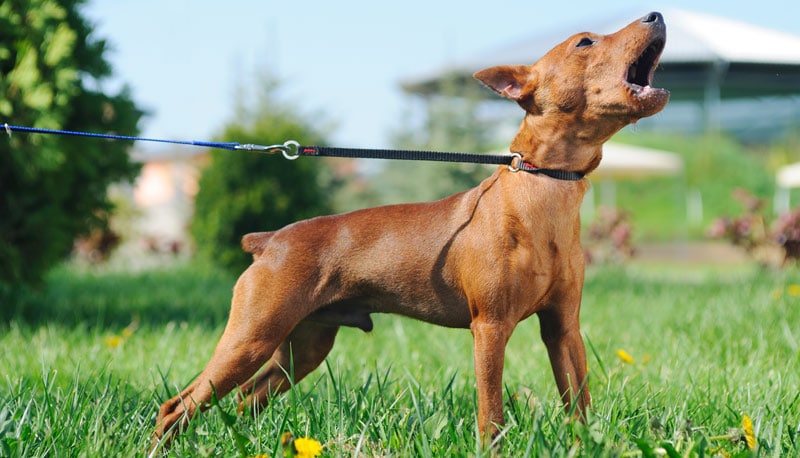 A tense or anxious dog is more likely to bark at noises, people, dogs and other triggers. He may also whine or howl.
A tense or anxious dog is more likely to bark at noises, people, dogs and other triggers. He may also whine or howl.
Most dogs bark, so this doesn’t always indicate stress. A stressed dog is more sensitive to noises that he usually wouldn’t notice, however, due to the higher levels of cortisol and adrenaline in his body. If you notice your dog’s behaviour towards something “isn’t like him,” stress could be the cause.
 Have you ever noticed yourself pacing a room when stressed? Many dogs do this too - especially when under prolonged stress. The classic “tail chasing” behaviour is also a sign of stress.
Have you ever noticed yourself pacing a room when stressed? Many dogs do this too - especially when under prolonged stress. The classic “tail chasing” behaviour is also a sign of stress.
If repeated enough, these behaviours can develop into an obsessive habit.
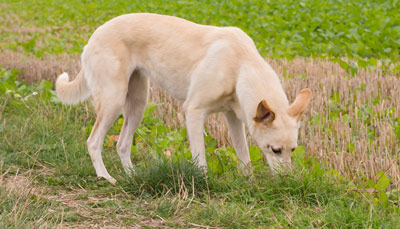 If you watch your dog greeting another dog or human, you may notice him focus on something else. Dogs use this technique to reduce the impact of a stress trigger. Common examples are turning the head away, sniffing the ground, or even genital licking.
If you watch your dog greeting another dog or human, you may notice him focus on something else. Dogs use this technique to reduce the impact of a stress trigger. Common examples are turning the head away, sniffing the ground, or even genital licking.
This is why some dogs start licking their genitals when you stop to talk to another owner on a walk. While it might seem embarrassing, it’s your dog’s reaction to being in an uncomfortable situation.
If you notice your dog showing displacement behaviours, calmly remove him from the trigger so he can relax. Don’t force the issue, as this can cause a more exaggerated reaction.
 Paw raising can be a sign of appeasement when a dog is stressed. Pawing at the owner may also be a signal that a dog is anxious and looking for reassurance.
Paw raising can be a sign of appeasement when a dog is stressed. Pawing at the owner may also be a signal that a dog is anxious and looking for reassurance.
On a side note, pawing isn’t a sign that the dog is trying to dominate or be “pack leader.”
 If displacement behaviours aren’t enough to reduce the intensity of a trigger, the dog may try to physically move away. Some dogs hide behind their owners or under a table when stressed. Others might even jump up at their owner to signal they want to be picked up or reassured.
If displacement behaviours aren’t enough to reduce the intensity of a trigger, the dog may try to physically move away. Some dogs hide behind their owners or under a table when stressed. Others might even jump up at their owner to signal they want to be picked up or reassured.
If your dog is trying to move away from a trigger, don’t try to stop him. Allow him to create some distance between himself and whatever is causing stress. A stressed dog that feels trapped may feel the need to growl or snap, which is sadly why many children - who don’t understand the dog’s need for space - get bitten.
Being on a leash can make stress worse if the dog is desperate to get away from a trigger. Many owners get caught up in a conversation on a walk and don’t realise their dog is stressed, which can cause cortisol levels to rise higher than necessary.
 If your dog has been house trained, indoor soiling can be a sign of stress. The release of stress hormones affects the digestive system, which may make it more likely for your dog to have an “accident.” This isn’t the dog being bad or lazy - he isn’t in conscious control.
If your dog has been house trained, indoor soiling can be a sign of stress. The release of stress hormones affects the digestive system, which may make it more likely for your dog to have an “accident.” This isn’t the dog being bad or lazy - he isn’t in conscious control.
Stress isn’t the only reason for indoor accidents though. Old age or illness can also cause a loss of bowel control.
 A stressed dog may direct feelings of tension onto objects, such as furniture, doors or bedding. This is why it’s common for a dog suffering from separation anxiety to destroy things when his owners are out.
A stressed dog may direct feelings of tension onto objects, such as furniture, doors or bedding. This is why it’s common for a dog suffering from separation anxiety to destroy things when his owners are out.
In some cases, this destructive behaviour is directed to the dog’s own body. Excessive licking, biting or self-harm can all be symptoms of severe stress.
 Aggressive behaviour towards other dogs, animals or people can be a sign of both acute and chronic stress. Lip curling, snapping, growling and biting are all common when a dog is stressed.
Aggressive behaviour towards other dogs, animals or people can be a sign of both acute and chronic stress. Lip curling, snapping, growling and biting are all common when a dog is stressed.
The aggression is often defensive and aimed at the trigger. For example, a child that’s crowding the dog’s space, or a cat walking along the garden fence.
Body Language Canine Stress Signals

Dogs are continuously communicating how they feel – but the signals of stress are often subtle and easy to miss. Many of these signals are also contextual and can mean different things.
The key is to know how your dog usually behaves, so you can identify changes. You should also assess your dog’s entire body language if you notice a potential stress signal, as there are likely to be multiple signs.
Here are a few examples:
- If a guest has arrived and your dog is licking his lips, has a stiff body, and ears pinned back, he’s clearly feeling stressed and uncomfortable.
- If you’re preparing dinner and he’s licking his lips but has a soft face and relaxed body posture, perhaps he’s just hopeful of getting a treat.
- If you’ve returned from a walk and your dog is panting and scratching, he’s likely to be hot and frustrated.
- If you’re standing talking to another dog walker and your dog is panting, yawning and averting his gaze, then he probably feels uneasy about being around the person or other dog.
- If your dog scratches, yawns or “shakes off” after a hug, he is likely to have felt restricted and stressed – even if your intention was to give affection.
Be aware that these signals don’t always occur at the same time as the trigger. Some of them, such as yawning or shaking off, are often after the trigger, as this is the dog’s way of trying to relieve tension.
The more you look for the signals below, the easier they’ll be to spot.
 Dogs don’t just “shake off” when they are wet. They also use it as a way to relieve stress after a trigger has occurred. This is similar to humans taking a deep breath when anxious.
Dogs don’t just “shake off” when they are wet. They also use it as a way to relieve stress after a trigger has occurred. This is similar to humans taking a deep breath when anxious.
In fact, shaking off has been shown to reduce adrenalin by at least 15%. So, this is a highly effective way for a dog to calm itself.
A common example is when a dog is picked up for a hug by the owner. You’ll often notice the dog shaking off as soon as he’s put back onto the floor, showing that he didn’t enjoy the hug. Many dogs also shake off after greeting a strange dog on a walk.
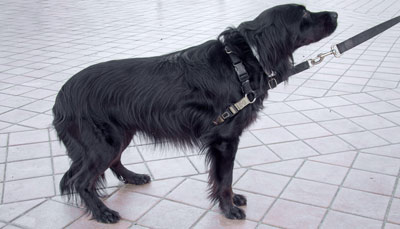 A scared or frightened dog will often put his tail between the back legs. Some dogs also put their tail straight down.
A scared or frightened dog will often put his tail between the back legs. Some dogs also put their tail straight down.
This tail position is likely to be combined with a rigid body posture, showing that he’s ready to take action.
 A subtle sign of stress is a tense facial expression - especially around the eyes and mouth. This can manifest as tightness around the jaw, scowling and a furrowed brow.
A subtle sign of stress is a tense facial expression - especially around the eyes and mouth. This can manifest as tightness around the jaw, scowling and a furrowed brow.
Unfortunately, this stress signal is often difficult to see in long-haired or brachycephalic (flat-faced) breeds.
 Yawning can be a sign of tiredness, but longer and more exaggerated yawns are often a signal of stress. While your dog might look relaxed, a wide yawn could show he’s not comfortable with the situation.
Yawning can be a sign of tiredness, but longer and more exaggerated yawns are often a signal of stress. While your dog might look relaxed, a wide yawn could show he’s not comfortable with the situation.
A yawn can also signal indifference to another dog. In this situation, yawning is an attempt to diffuse the situation and show the other dog or person they aren't a threat.
 A dog showing the whites of his eyes may feel stressed or anxious. This is typically combined with averting the head, while keeping the gaze fixed on whatever is causing the stress - a signal known as “whale eye” or “half-moon eye.”
A dog showing the whites of his eyes may feel stressed or anxious. This is typically combined with averting the head, while keeping the gaze fixed on whatever is causing the stress - a signal known as “whale eye” or “half-moon eye.”
This is more difficult to spot in breeds that naturally have more eye white showing, such as pugs. In these cases, look for the amount of white you can see compared to normal, combined with other body language signals.
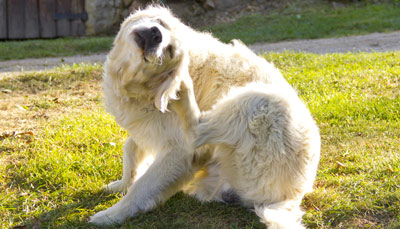 Scratching is a common sign of frustration, stress or excitement in dogs. This is a form of displacement behaviour that helps the dog focus on something other than the stressor.
Scratching is a common sign of frustration, stress or excitement in dogs. This is a form of displacement behaviour that helps the dog focus on something other than the stressor.
You'll often see a dog scratching when he's waiting for a walk or food. This can be a frustrating experience for the dog, especially if he would usually have been fed or walked at the current time.
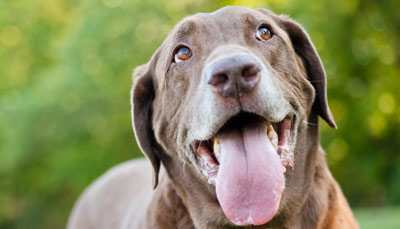 As with many canine body language signals, panting can mean several things depending on the situation.
As with many canine body language signals, panting can mean several things depending on the situation.
The most obvious reason for panting is to cool down. This is vital for dogs, as they can’t sweat like humans.
If a dog is panting without exercise or excessive heat, however, it could be a sign of stress or pain. Many dogs also salivate when stressed.
 Some dogs pull back or flatten their ears when stressed or anxious. Others have ears that stiffen or become erect when they are uncomfortable.
Some dogs pull back or flatten their ears when stressed or anxious. Others have ears that stiffen or become erect when they are uncomfortable.
It’s important to know how your dog’s ears react to stress, as this is an easy way to spot when he feels uneasy.
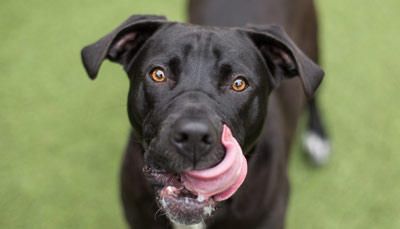 Licking the lips or nose is a classic sign of stress or anxiety in dogs. You’ll often notice it when a dog feels crowded as a human approaches.
Licking the lips or nose is a classic sign of stress or anxiety in dogs. You’ll often notice it when a dog feels crowded as a human approaches.
Of course, dogs also lick their lips when they are anticipating food, so it’s not always a stress signal.
 A stressed dog may try to make himself smaller by crouching.
A stressed dog may try to make himself smaller by crouching.
He is also likely to tense his muscles in preparation for action.
Shaking or shivering - especially in a warm environment - is a sign of fear and stress. This type of body language is common during prolonged stressful events, such as a thunderstorm or fireworks display.
Note: Some dogs are more difficult to “read” than others. Brachycephalic breeds, such as pugs and bulldogs, have a squashed face and larger eye whites, which can make it difficult to see their facial expressions. The same is often true for dogs with long hair.
Health and Welfare Stress Signals

Stress doesn’t just impact a dog’s emotions at the time of the event. Chronic stress can also cause longer-term changes to a dog’s behaviour and health.
However, while stress can cause the problems below, they can also be a symptom of illness or disease. For this reason, always contact your vet if you notice a change in your dog’s behaviour or health.
A stressed dog may suffer from digestive problems, such as constipation or diarrhea. This is because stress increases the amount of norepinephrine in the body, which affects gut bacteria.
You should always contact a vet if your dog’s digestive problems last longer than 24 hours, or if you notice blood in the stool.
Chronic stress can cause a dog to become less interested in food. Some dogs even stop eating entirely. This can lead to weight loss and serious health consequences.
Contact a vet immediately if you notice your dog isn’t interested in eating. While it could be caused by stress, there are also many medical conditions that can cause a change in appetite.
Long-term stress may cause a dog to show similar symptoms to human depression. These include difficulty sleeping (or sleeping longer) and a lack of energy. The dog may also seem less enthusiastic about playing or food.
Some dogs suffering from chronic stress want to be alone more often than usual. If you notice your dog doesn’t want to spend time with people, it could be suffering from illness or anxiety.
Dogs under stress often shed more hair. This is commonly seen when visiting the vets, although any stressful situation can cause increased shedding. Chronic stress can lead to hair loss and bald patches.
As with many of the other stress signals on this list, hair loss and shedding can also be caused by various medical conditions. So, if you notice your dog losing more hair than usual, discuss it with a vet.

Trigger Stacking
Cortisol can remain in the body for hours after it’s secreted. If a dog faces another stress trigger before cortisol levels have returned to normal, a much larger amount is potentially released. This is known as “trigger stacking.”
When trigger stacking occurs, a dog’s already stressed state can cause him to react to triggers he would usually ignore. The more stress triggers the dog experiences, the more elevated his stress hormones become. A dog that’s above his stress threshold also reacts in a more exaggerated way to triggers.
It can take several days for a dog’s cortisol levels to return to normal after a particularly stressful event. If he’s faced with another stress trigger during this time, he’s more likely to react, as it takes a smaller trigger for him to reach his threshold.
In practice, this is why a dog might hear cars drive by the house all day, but then suddenly start barking at cars after a guest arrives. Or why a dog may not seem to mind the first few dogs on a walk, but react aggressively to one later on.
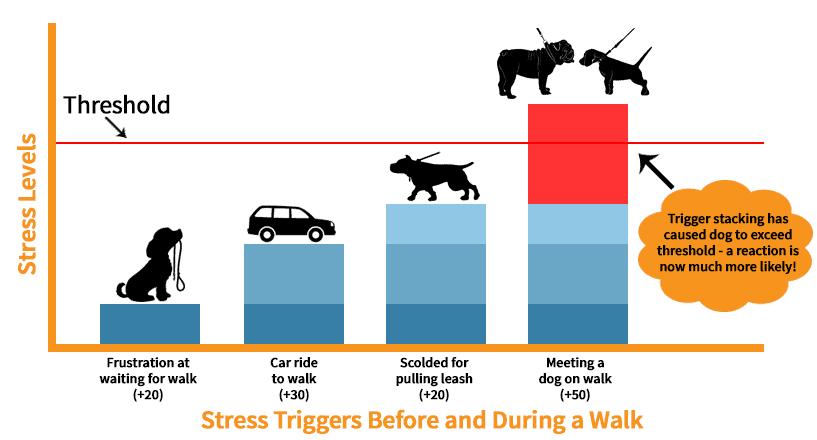
Here’s another (very) simplified example. Imagine a dog had a stress threshold of “100,” and above this threshold he couldn’t cope with additional stressors. If the stress trigger of “meet a dog” had a value of +50, then he would be unlikely to react when meeting a dog, although he may still show stressed body language, because it’s under his threshold.
But now imagine a sequence of events before meeting a dog:
- The dog is anticipating a walk and getting frustrated by having to wait (+20)
- When it’s time for a walk, he must travel in a car which he doesn’t enjoy (+30)
- Upon arriving at the walk, he is scolded by his owner for pulling on the leash (this increase in stress is one of the reasons why negative training is a problem) (+20)
The dog now has an imaginary stress rating of +70. When he meets the dog, which is +50, he’s pushed over his 100 threshold and is much more likely to lunge or bark.
That’s why it’s important to think about all the potential stress triggers leading up to stress-induced behaviour. If you only focus on the final trigger, you might be missing the rest of the stack.
How to Relieve Canine Stress and Keep Your Dog Happy
Once you’ve identified your dog is stressed, the next step is to provide relief. This might be as simple as removing the trigger, but often involves a combination of short-term calming techniques and long-term training.
How to Handle a Stress Trigger
The first step to relieving stress is always to either remove the trigger or move the dog away from the trigger.
Don’t force the dog to remain in the situation. This is only going to increase his cortisol and adrenaline levels, while creating a stronger negative association with the trigger.
Allow your dog a moment to decompress. Then, if they are calm enough, ask for some basic behaviours they already know, such as “paw” or “sit”. This activates the prefrontal cortex (logical part of the brain) rather than the amygdala (fight or flight part of the brain).
If they are still too wary of the trigger to respond, try scattering a few treats on the floor instead. This is a low-pressured way to distract your dog. It also encourages sniffing, which is a naturally calming behaviour.
The above methods may not work if your dog is still highly aroused though. If you can’t get his attention, or he seems unwilling to eat a treat, just remove him from the situation and allow time to calm down.
Remember, cortisol has a half-life of over an hour. Even if he seems relaxed a few minutes later, the dog is still in a stressed state and more likely to react to other triggers.
Changing Your Dog’s Reaction to a Trigger
Now you’ve identified a stress trigger for your dog, the next step is starting a desensitisation and counter-conditioning program to reduce the chance of a reaction in the future. It’s important to combine the two, as desensitization reduces the intensity required to trigger a reaction, while counter-conditioning changes the response.
Ultimately, the goal is to transform a stress trigger into a neutral or positive stimulus, by combining it with something he already loves. This is food, in most cases, but treats and toys can also work.
Desensitization must be performed slowly and with gradually increased intensity though. Remember, the stress response is subconscious, so it takes many positive experiences to rewire your dog’s brain. Trying to rush can make things worse.
This isn’t always an easy process, so it’s best to hire a canine behaviourist to help. Here’s a simplified overview though:
- Step 1: Determine exactly what is triggering the stress reaction. If there are multiple triggers, choose a single stressor to work on first. Examples could include the sound of a vacuum cleaner, getting into a car, or a thunderstorm.
- Step 2: Find a way to reduce the intensity of the trigger below your dog’s reaction threshold. If your dog gets stressed when he hears a specific loud noise, perhaps you could find a recording of the noise and play it at a low volume. If your dog is scared of car journeys, you may find he starts getting stressed when he leaves the house, so you should begin training before this point (possibly with putting his harness on).
- Step 3: Create a positive association with the low-intensity version of the trigger. Food is often the best motivator for a dog, as it elicits a positive feeling. Use tasty treats and praise to associate a good feeling with the “easy” trigger.
- Step 4: Repeat until the dog is clearly associating positive reinforcement with the low-intensity trigger. The most common mistake is increasing the intensity of a trigger before the dog has had a chance to fully associate it with positive feelings. Instead, practice with the low-intensity trigger until your dog starts looking for a treat when the trigger happens.
- Step 5: Gradually increase the intensity and repeat the process. Once your dog associates positive feelings with the current trigger, you can slightly increase the intensity and repeat the process. For noise-based triggers, this is often as simple as making the sound slightly louder. For other triggers, you’ll need to find the next step that doesn’t cause a stress response.
Remember, the goal is to always stay below your dog’s stress threshold. If he starts to show signs of stress or anxiety, finish the training session with a treat and praise, then reduce the intensity next time.
Other Tips for Reducing Stress
There are plenty of other things you can do to help your dog feel less stressed. These include:
- Provide enough exercise to meet your dog’s requirements. Every breed needs a different amount of exercise, but physical activity is a proven stress reliever for both humans and dogs.
- Make sure your dog always has access to a safe and quiet space in your home. This could be a comfortable bed or dog crate in a quiet room. Some dogs also like snuggling into cave beds, as they provide more security. Everyone in the household should know to leave the dog alone when he’s in his safe space.
- Dogs thrive on consistent routines. Try to feed and walk your dog at similar times each day, while making sure the dog isn’t left alone for long periods.
- Mental stimulation is often just as important as physical. Indoor games and puzzle feeders are two great ways to provide mental stimulation. A long-lasting chew, such as an antler horn, can also be useful.
- Practice positive training methods. Punishment – whether that’s verbal, physical, or through the use of aversive training tools – increases a dog’s anxiety and can lead to chronic stress.
- Chewing and sniffing are naturally calming activities for dogs, so chews and snuffle mats are two of the best ways to relax your dog without physical exercise. If you don’t have a toy available, just hiding a few treats around the house can work. You may also want to read our guide to indoor activities for dogs, which has other suggestions for fun games.
- Make sure everyone in the household knows how to respect the dog’s personal space and sleeping time.
Complementary Therapies
There are a number of complementary therapies that could help your dog feel more relaxed. While they aren’t guaranteed to help all dogs, they are certainly worth experimenting with.
Keep in mind that these therapies aren’t designed to replace medical treatment.
Flower Essences
Many vets and other canine professionals use flower essences as a way to relieve stress. These are extracted from the flowers of various plants, and can be effective at reducing mild anxiety.
Typically, the essence is diluted and then sprayed onto an old piece of cloth. The dog can then benefit from the relaxing effects of the essence over an extended period.
While there aren’t many clinical trials using flower essences with dogs – most studies have been performed on humans – this type of treatment is safe (when used correctly), has no reported side effects, and is relatively cheap. Essences are also easy to buy and don’t interact with other medical treatments.
Choosing the right flower essence takes practice though. Dogs have an incredible sense of smell, so picking an essence your pet doesn’t like can cause more harm than good. Every dog has personal preferences, so it takes a trained eye to tell if they are enjoying the smell.
Even more importantly, many flower essences can be toxic for dogs. So, for these reasons, we only recommend using flower essences with the assistance of a canine aromatherapist. They’ll help you trial various safe essences to find the best for relieving your dog’s stress.
Body Wraps
Body wraps, which are also known as anxiety wraps, apply a mild pressure to the dog’s body. This is said to release endorphins that provide a sense of calm and happiness, in a similar way to stroking a dog across the back.
Like flower essences, there’s a lack of scientific evidence that anxiety wraps work. There are, however, many anecdotal stories of dogs becoming less anxious and stressed when wearing one.
While some dog professionals recommend wraps, others think the dog may just feel restricted and less able to move, rather than less stressed. Many owners also only get the dog to wear the vest during stressful situations, which can create a negative association that increases anxiety.
So, while vests are unlikely to hurt, there is disagreement over whether using one will help your pet. If you decide to use one, make sure you practice wearing the vest when your dog is happy and relaxed.
Calming Music
Music can have a gentle calming effect on a dog. It also reduces the chance of your dog hearing potential stress triggers, such as the postman arriving or a car pulling up outside the house.
Surprisingly, choosing the correct genre of music is vital when trying to reduce anxiety. A recent study showed that soft rock and reggae, on average, had the most calming effect. Classical music also reduces anxiety, but Motown actually increased stress!
There’s some evidence that dogs become “bored” when listening to the same type of music, which reduces the positive effects. To prevent this, try mixing up the genre and playlist.
Dog Appeasing Pheromones (DAPs)
When a female dog lactates, she releases pheromones that have evolved to reassure her puppies and reduce stress. These pheromones appear to have the same effect on dogs of any age, which is why DAP collars, sprays and diffusers have become increasingly popular.
Several studies have shown that DAPs can relieve anxiety and stress. One tested DAPS on hospitalized dogs, which show signs of separation anxiety and fear. They found that the dogs were less likely to lose control of their bowels, showed a reduction in obsessive licking, and didn’t pace as much. Another study found that dogs with a DAP collar were significantly less anxious and fearful during a thunderstorm.
When Should You See a Vet?
The physical symptoms of stress are the same as those caused by a variety of medical conditions. For this reason, you should always visit a vet if you notice a change in your dog’s behaviour, health, appetite, sleep, or toilet habits.
During the examination, your vet will ask for a recent history of your dog. This could include the frequency and severity of symptoms, his current living conditions, daily routine, and whether there have been any changes in circumstances. Your vet may also order blood tests, fecal tests and medical imaging to eliminate other potential causes.
Once stress is identified as the cause of the symptoms, your vet can help you design a treatment plan. This could include many of the tips above, but may also involve medication and supplementation to reduce anxiety.
If your vet rules our underlying illness or injury, it’s also important to contact a canine behaviourist who specialises in force-free techniques. A behaviourist can help you uncover your dog’s stress triggers and design a desensitisation program.

Post-Traumatic Stress in Dogs
Many animals can suffer from post-traumatic stress disorder (PTSD). Sadly, dogs are no exception.
PTSD is caused by a dog being exposed to severe trauma. This could be abuse, serious accident, loss of a loved one, negative interactions with another animal or dog, war, or being abandoned. Trauma as a young puppy can also cause long-term PTSD, as it interferes with critical stages in the dog’s brain development.
Many of the symptoms of PTSD are the same as “normal” stress, such as difficulty relaxing, aggression, clinging to the owner, depression and behaviour change. A dog with PTSD is also likely to try and avoid anything that triggers memories of the trauma, while remaining in a state of hypervigilance. Nightmares are also common.
While canine PTSD is relatively rare in the general population, it does happen and can be difficult to treat. Your vet may recommend desensitization to the trauma triggers, positive reinforcement training, and anxiety-reducing medication. Even with these methods, it can take years for a dog to overcome PTSD.
Summary
Stress can have a severe impact on your dog’s happiness, health and wellbeing.
The key is to be aware of your dog’s stress signals. Once you start looking for body language cues or subtle changes in behaviour, you’ll realise your dog is continuously trying to communicate his feelings.
The good news is there are many ways to reduce stress. Removing triggers and starting a desensitization/counter-conditioning program are both vital steps, but exercise, providing a safe space and mental stimulation can also help.
You may want to try complementary therapies, such as dog appeasing pheromones and relaxing music. These can’t replace medical treatment, but can be surprisingly effective at calming a dog.
With that said, you should contact your vet if you notice signs of chronic stress. He or she can rule out underlying medical causes, while helping you decide on the best approach to relieving stress.
Do you have any questions about the signs of stress in dogs? Please let us know in the comments section below.

I found this article so full of imformation, very helpful 🙂
Thanks Pat, I’m glad you found the article helpful.
Great great article!!!
Thanks Kerryn, I’m glad you enjoyed it!
Thank you so much! My baby is suffering and I am never sure what to do. Thank you for sharing these insightful tips.
very helpful article – thank you!